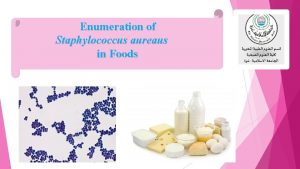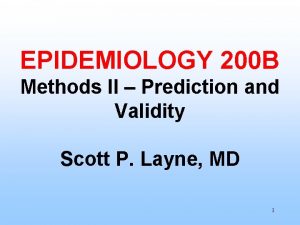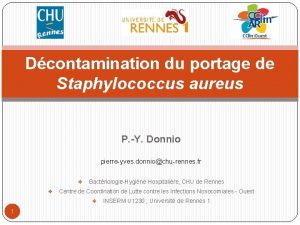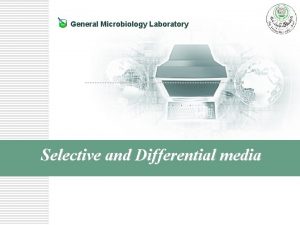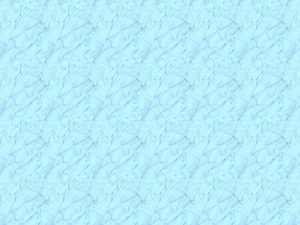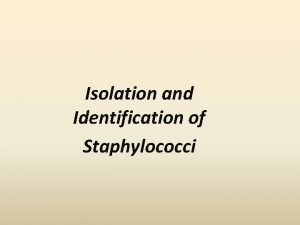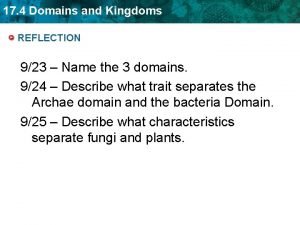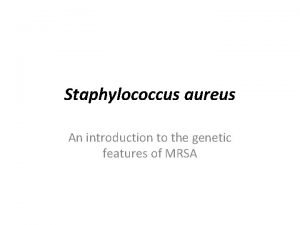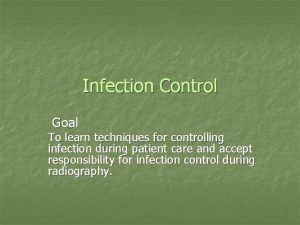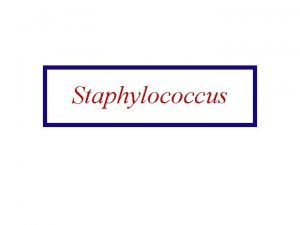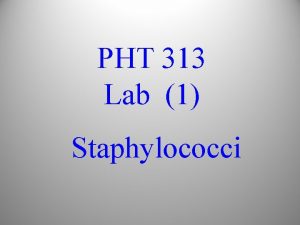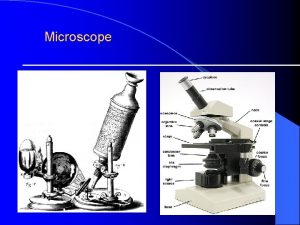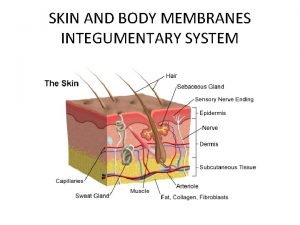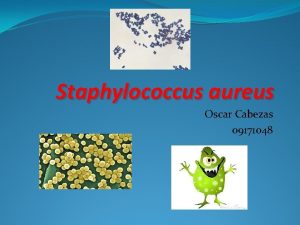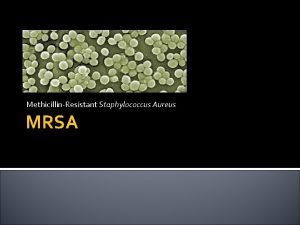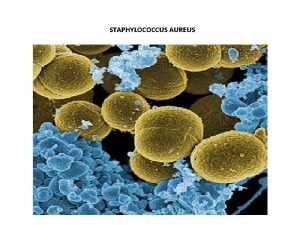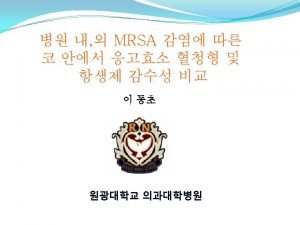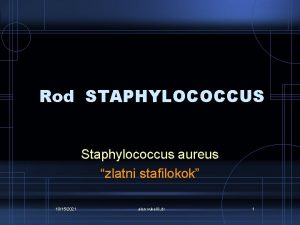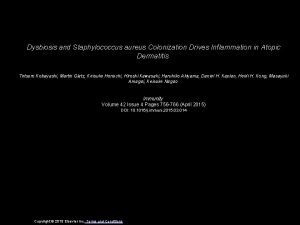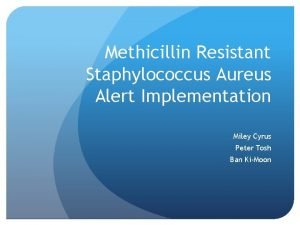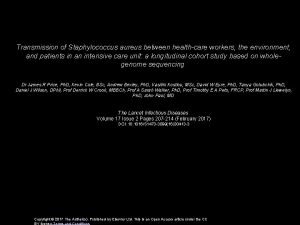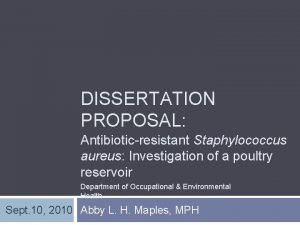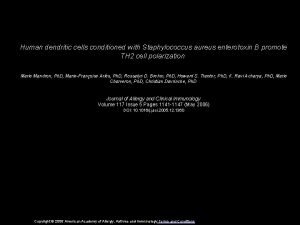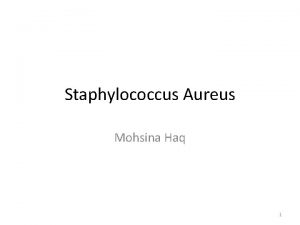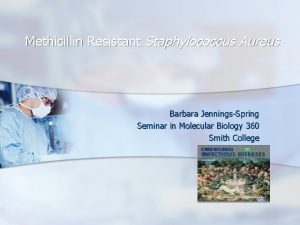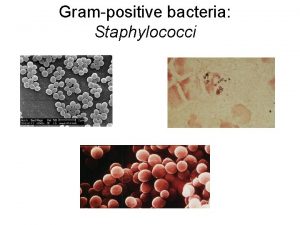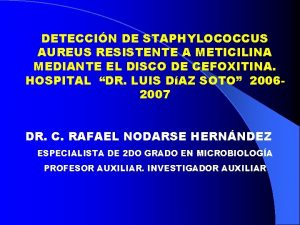Staphylococcus aureus An introduction to the genetic features


























- Slides: 26

Staphylococcus aureus An introduction to the genetic features of MRSA

What is a pathogen? • A pathogen is a disease causing agent Bacteria Fungus Protozoa Virus Images: Janice Carr; CDC/Dr. Godon Roberstad; Wellcome Images; Anna Tanczos, Wellcome Images

Question Can you name a disease caused by bacteria?

Structure of bacteria

Staphylococcus aureus • Widespread bacteria: – Natural flora of the skin of 30% of the population • Versatile pathogen associated with a wide range of diseases: – – Image: Sharon Peacock, Oxford University Minor wound infections Food poisoning Toxic shock syndrome Heart infections

How does S. aureus cause disease? • Bacteria have a range of molecular “weapons” to help them invade a host and evade detection. • What do you think these “weapons” are?

The S. aureus arsenal Fibronectin binding protein Collagen binding protein Toxins Hemolysins Leukocidins Enterotoxins Exfoliative toxins Toxic shock syndrome toxin Clumping factor S. aureus Protein A Elastin binding protein Matrix adhesion factor Surface proteins Enzymes Lipases Esterases Nucleases Coagulases Phospholipase C Extracellular proteins

What is a surface protein? • Surface proteins are found on the outside of S. aureus. • They enable it to attach to host cells aiding tissue invasion and colonisation. • Examples: – Elastin binding protein – Collagen binding protein

What is a toxin? • A protein that has the ability to damage specific cells and cellular components. Q. Can anyone think of a disease or syndrome caused by bacterial toxins?

Staphylococcal Scalded Skin Syndrome • SSSS is an exfoliative dermatitis, a condition where skin flakes or peels off. • Causal Factor : Exfoliative toxins A and B. • Can vary in severity ranging from a few localised blisters to generalised exfoliation covering almost the entire body. Images: CDC

Toxic Shock Syndrome • Symptoms: sudden onset of fever, chills, vomiting, diarrhoea, muscle aches and rash. Can lead to hypotension and anaphylactic shock which can lead to organ failure. • Causal factor: S. aureus toxic shock syndrome toxin. • Associated with tampon use and also as a complication of skin abscesses or surgery. Strawberry tongue symptom of TSS Image: CDC

What is an enzyme? • Enzymes break down organic compounds of cells and tissues, allowing the bacteria to absorb nutrients and also to spread through body tissues. • Examples: – Protease – Coagulase – Lipase

How do you treat S. aureus infections? • Diseases caused by S. aureus are usually treated with bactericidal antibiotics and the patient is normally free of pathogenic bacteria within a month. • Antibiotics include: – penicillin – oxacillin – nafcillin Image: Bmramon/wikimedia commons

Superbugs & antibiotic resistance • Methicillin resistant Staphylococcus aureus (MRSA) is termed a “superbug”. • Common cause of hospital acquired infection. • Hospital-acquired MRSA infections lead to: – prolonged hospital stay – increased costs to NHS

How does resistance occur? • Use of antibiotics creates a selective pressure. • Only bacteria with genes that confer resistance can survive a treatment of antibiotics. • Eventually resistant bacteria can make up the majority of the population. Population after Before antibiotics Add antibiotics

Genetic diversity of bacteria • Bacteria are under continuous selection pressure and are constantly evolving to adapt to changes in their environment. • How? – Mutations occur within the genome during DNA copying and because of damage to DNA which confer a selective advantage. – Horizontal gene transfer (direct exchange of genes between individual bacteria).

Horizontal transfer • New antibiotic genes can be acquired via horizontal transfer or conjugation. Images: Genome Research Limited

Viewing diversity S. aureus comparative genomics 8325 USA 300 COL Mu 50 N 315 MW 2 MSSA 476 MRSA 252 RF 122 0 Mb 1. 0 Mb Staphylococcal cassette chromosome (SCC) element Genomic islands shared with other S. aureus strains Pathogenicity islands 2. 0 Mb Integrated plasmid Prophage Transposon Tn 916 -like element 3. 0 Mb

Activity: MRSA gene hunt • Identify and classify genes from the genomes of two S. aureus strains. – MSSA 476: Methicillin susceptible strain but resistant to penicillin and fusidic acid (commonly used antibiotics). – MRSA MW 2: Extremely virulent and resistant to methicillin.

Gene ID cards Gene ID: gene name Description of the protein product and function Strain of bacteria

Complete your worksheet Write protein product here Write role or function of protein here

Answers Gene Protein product Function MSSA 476 MRSA MW 2 Classification ccr. A & ccr. B Cassette chromosome recombinase A & B Allows new chunks, or “cassettes” of DNA to be inserted into the bacterial genome. Mobile genetic element ear Enterotoxin B Attacks cell membranes which can lead to the cell bursting and dying as a result. Toxin int (region 3) Intergrase Helps insert DNA copied from viral RNA or DNA into the bacterial genome. Mobile genetic element fus. B 1 Fusidic acid resistance protein Blocks the action of fusidic acid making the bacteria resistant to common antibiotic skin creams and ointments. Antibiotic resistance hsd. R, hsd. S & hsd. M Restriction modification enzymes Acts as a barrier against ‘free-for-all’ horizontal transfer of DNA protecting the bacteria’s genome from invading fragments of DNA which could “weaken” it. Enzyme

Answers Gene Protein product Function MSSA MRSA 476 MW 2 Classification orf. X Surface protein / gene insertion site A surface protein which marks the sites on the genome where mobile genetic cassettes can insert themselves. Surface protein luk. S & luk. F Panton-Valentine leukocidine chain precursors S & F Part of the Panton-Valentine leukocidin complex. When secreted they combine to form a ring with a hole in the middle, within the membrane of target cells. This causes the contents of the cell to leak out and the cell to die. Toxin mec. A Penicillin binding protein Blocks penicillin-based antibiotics which stop synthesis of the bacterial cell wall to prevent growth and division. Antibiotic resistance

Answers Gene Protein product Function sec 4 Enterotoxin type c precursor sel 2 Enterotoxin L MSSA 476 MRSA MW 2 Classification A precursor to an enterotoxin. It has to be modified by another enzyme to become an active toxin. Once activated the toxin can damage cells in the gut which leads to symptoms such as diarrhoea. Toxin A type of superantigen capable of causing a variety of symptoms by destroying the host’s cells. It stimulates the body to produce a large number of “T” immune cells, which damage healthy tissues around or near the area infected with S. aureus. This can cause extensive damage to tissues and major organs sending the body into shock. Toxin

Summary Antibiotic resistance Enzyme Surface protein Toxin Mobile genetic element fus. B 1 hsd. R, hsd. S & hsd. M orf. X ear ccr. A & ccr. B luk. S & luk. F int mec. A sec 4 sel 2 Key: MSSA 476 only MRSA MW 2 only Both strains

Discussion point • MRSA can be treated with vancomycin. However the first vancomycin-resistant strains were discovered in 2003. • What are the implications of this?
 Confirmation test for staphylococcus aureus
Confirmation test for staphylococcus aureus Staphylococcus
Staphylococcus Staphylocoque mrs1
Staphylocoque mrs1 Differential vs selective media
Differential vs selective media Micrococcaceae staphylococcus
Micrococcaceae staphylococcus Staphylococcus aureus
Staphylococcus aureus Gamma hemolysis
Gamma hemolysis Nitrate reduction test staphylococcus aureus
Nitrate reduction test staphylococcus aureus Staphylococcus aureus?
Staphylococcus aureus? Three domains of life
Three domains of life Enzymes of staphylococcus aureus
Enzymes of staphylococcus aureus Nummular eczema
Nummular eczema Staphylococcus aureus
Staphylococcus aureus Staphylococcus aureus bacteria structure
Staphylococcus aureus bacteria structure Staphylococcus aureus cocci or bacilli
Staphylococcus aureus cocci or bacilli Enzymes of staphylococcus aureus
Enzymes of staphylococcus aureus Prokaryotic cell wall
Prokaryotic cell wall Founder effect genetic drift
Founder effect genetic drift Genetic programming vs genetic algorithm
Genetic programming vs genetic algorithm Genetic programming vs genetic algorithm
Genetic programming vs genetic algorithm Genetic drift
Genetic drift Genetic drift vs genetic flow
Genetic drift vs genetic flow Staph aureus morphology
Staph aureus morphology White
White Mac plate results
Mac plate results Streptococcus aureus
Streptococcus aureus Streptococcus aureus
Streptococcus aureus
